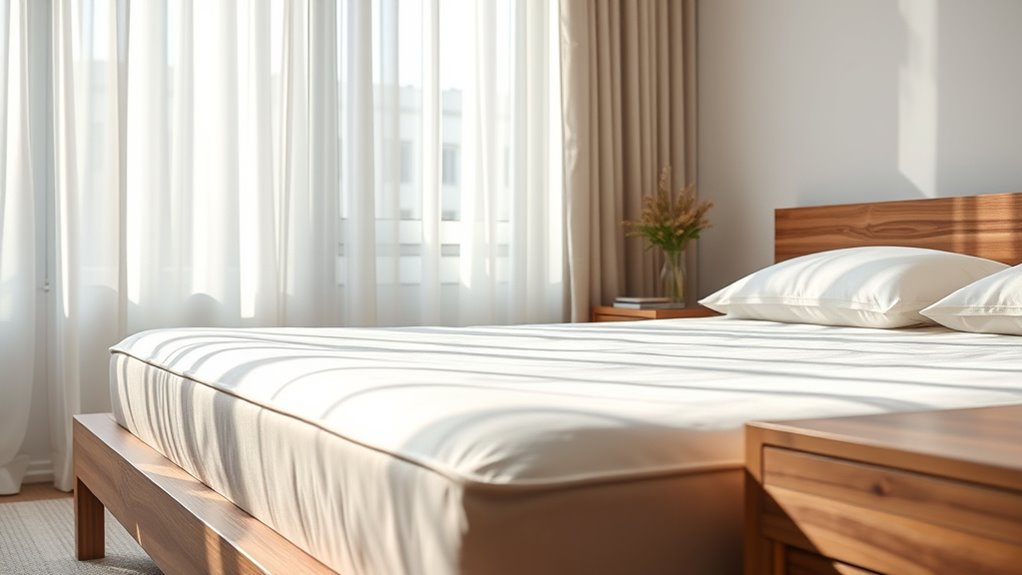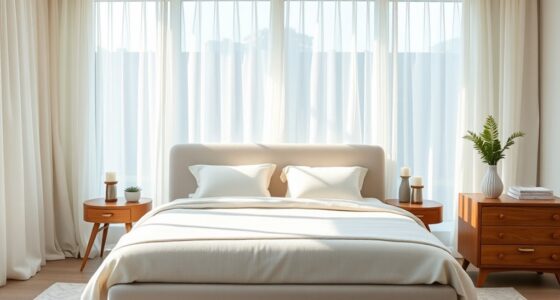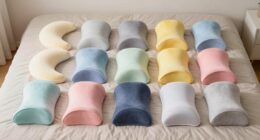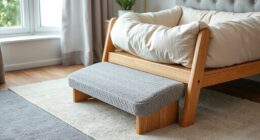VOCs, or volatile organic compounds, are chemicals released into the air from materials in your bedroom furniture and mattresses, especially if they’re made with pressed wood, foam, or synthetic fabrics. These emissions can cause health issues like headaches, irritation, or long-term respiratory problems. New furniture tends to emit more VOCs initially, but some can continue for years. To reduce risks, choose low-VOC or natural options and improve ventilation—know more about how to create a healthier sleeping space.
Key Takeaways
- VOCs are airborne chemicals released from furniture and mattresses made with pressed wood, foam, and synthetic fabrics.
- Off-gassing is the process where VOCs evaporate from household items, often peaking when products are new.
- Prolonged VOC exposure can cause health issues like respiratory problems, headaches, and irritation.
- Choosing low-VOC or VOC-free furniture and mattresses helps reduce indoor chemical emissions.
- Proper ventilation and air purifiers can help lower VOC concentrations in bedrooms, improving air quality.
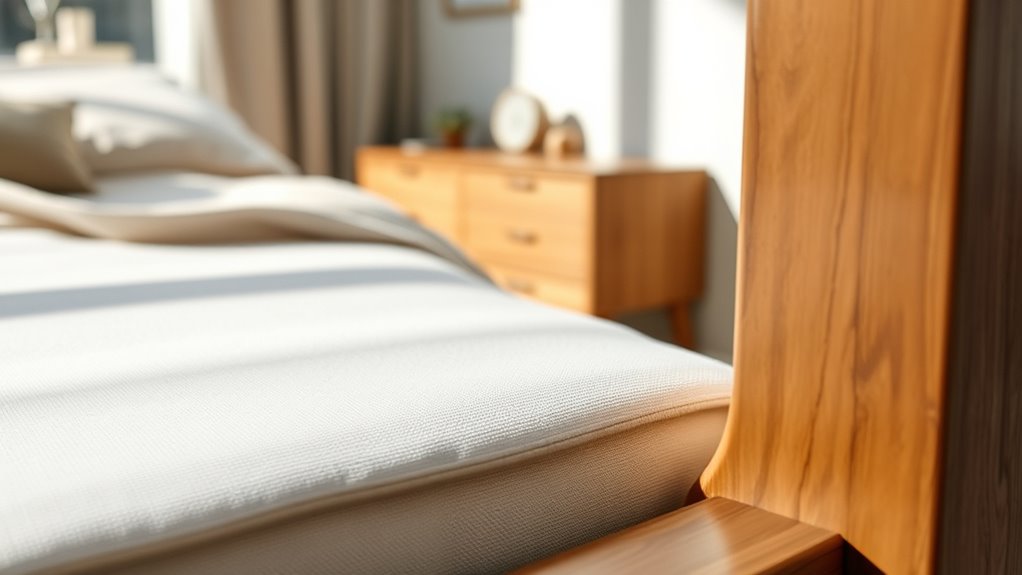
Have you ever wondered if the furniture and mattress in your bedroom could be releasing harmful chemicals? It’s a valid concern, especially since these items are in close contact with you every night. Many people overlook the potential impact that chemical emissions from household products can have on air quality concerns. When furniture and mattresses contain certain materials, they can emit volatile organic compounds (VOCs), which are airborne chemicals that can linger in your indoor environment. These emissions aren’t just a minor issue—they can affect your health over time, contributing to respiratory problems, allergies, or even more serious conditions.
Understanding VOCs in bedroom furniture and mattresses is essential because these chemicals are released through a process called off-gassing. It happens when volatile compounds evaporate from materials like pressed wood, foam, or synthetic fabrics. Many furniture manufacturers use adhesives, finishes, and flame retardants that contain VOCs, often without consumers knowing. When you bring new furniture or a new mattress home, these chemical emissions can be strongest initially but may continue to release at lower levels for years. This persistent off-gassing creates a constant source of indoor air contamination that can compromise your air quality concerns.
Off-gassing from furniture and mattresses can release harmful VOCs for years.
The impact of chemical emissions from these household items isn’t just about the smell; it’s about the potential health effects. Short-term exposure can cause headaches, dizziness, or irritation of the eyes and throat. Long-term exposure, especially in poorly ventilated bedrooms, can lead to more significant health issues, including asthma or other respiratory conditions. This makes it essential for you to be aware of what’s in your bedroom furniture and mattress and how it may be affecting your indoor environment.
Fortunately, there are steps you can take to minimize these risks. Start by choosing products labeled as low-VOC or VOC-free, which indicates they emit fewer or no harmful chemicals. Look for furniture made from solid wood or natural materials, and opt for mattresses with organic or chemical-free certifications. Proper ventilation is also key—opening windows regularly and using air purifiers with activated carbon filters can help reduce the concentration of chemical emissions in your bedroom. While it might require a bit more effort, prioritizing low-emission furniture and mattresses can greatly improve your indoor air quality and your overall health.
Frequently Asked Questions
How Can I Test for VOC Levels in My Bedroom?
To test for VOC levels in your bedroom, start with air quality testing kits designed for VOC detection. These kits are easy to use and give you quick results. You simply place the device in your room, wait, and then read the results. For more accurate assessments, consider hiring a professional to perform detailed air quality testing. This way, you can identify and reduce harmful VOCs effectively.
Are VOC Emissions From Furniture and Mattresses Constant Over Time?
Did you know VOC emissions from furniture and mattresses can decay by up to 80% within the first year? Over time, VOC emission decay occurs as materials age, meaning emissions generally decrease. So, your furniture’s VOC emissions aren’t constant; they lessen as the furniture ages. This means that, after a few years, your bedroom might have markedly lower VOC levels than when you first bought the items.
What Are the Long-Term Health Risks of VOC Exposure in Bedrooms?
You might wonder about the long-term health risks of VOC exposure in bedrooms. Poor indoor air quality from VOCs can lead to chronic health effects like headaches, respiratory issues, and allergies over time. Prolonged exposure increases risks, especially if ventilation is inadequate. To protect yourself, guarantee good airflow, choose low-VOC furniture and mattresses, and regularly air out your bedroom to reduce VOC buildup and safeguard your health.
Do Natural or Organic Materials Emit Fewer VOCS?
Imagine choosing a mattress made from natural latex with organic certifications—it’s likely to emit fewer VOCs. Natural alternatives, like solid wood furniture or organic fabrics, generally have lower VOC emissions compared to synthetic options. Certifications guarantee the materials meet strict standards, giving you peace of mind. By opting for these, you reduce indoor air pollution and create a healthier sleeping environment.
Can Ventilation Eliminate VOCS From Bedroom Furniture Entirely?
Ventilation effectiveness can substantially reduce VOC levels but won’t eliminate them entirely. You should use VOC reduction techniques like increasing airflow, using air purifiers, and choosing low-emission furniture. While proper ventilation helps, some VOCs may linger in the air or materials. To guarantee healthier indoor air quality, combine ventilation with other strategies like selecting eco-friendly furniture and maintaining good indoor humidity.
Conclusion
By choosing furniture and mattresses free from VOCs, you’re planting seeds of safety and peace in your sanctuary. Imagine your bedroom as a calm lake, free of ripples and toxins, where restful sleep flows effortlessly. When you prioritize low-VOC materials, you’re nurturing a home that shields you from invisible storms. It’s your personal haven—where every breath is a gentle breeze and tranquility blossoms, reminding you that comfort and health grow hand in hand.
